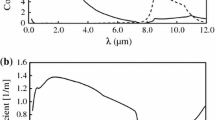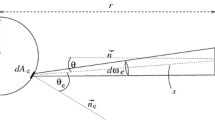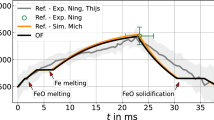Abstract
In the present study, absorption and scattering efficiencies as well as the scattering phase function of a cloud of coal particles are described as function of the particle combustion progress. Mie theory for coated particles is applied as mathematical model. The scattering and absorption properties are determined by several parameters: size distribution, spectral distribution of incident radiation and spectral index of refraction of the particles. A study to determine the influence of each parameter is performed, finding that the largest effect is due to the refractive index, followed by the effect of size distribution. The influence of the incident radiation profile is negligible. As a part of this study, the possibility of applying a constant index of refraction is investigated. Finally, scattering and absorption efficiencies as well as the phase function are presented as a function of burnout with the presented model and the results are discussed.









Similar content being viewed by others
Abbreviations
- a :
-
Curvature parameter
- E :
-
Distribution of black body radiation, normalized
- T :
-
Temperature (K)
- B :
-
Burnout
- D :
-
Particle size (μm)
- s :
-
Spread factor in particle size distribution
- ΔD :
-
Local particle interval(μm)
- I :
-
Radiative intensity (W/m2)
- k :
-
Imaginary part of index of refraction (m)
- m :
-
Complex index of refraction
- n :
-
Real part of the index of refraction (m)
- P(D):
-
Particle size distrib. (propability density formulation)
- Q :
-
Efficiency
- x :
-
Size parameter \(x =\pi {D}/{\lambda }\)
- λ :
-
Wavelength (μm)
- Δλ :
-
Local wavelength interval (μm)
- Φ :
-
Scattering phase function
- θ :
-
Azimuthal angle (rad)
- φ :
-
Polar angle (rad)
- ω :
-
Solid angle (sr)
- Δω :
-
Solid angle interval (sr)
- Δθ :
-
Interval in θ (rad)
- T:
-
At a certain temperature
- a:
-
Ash
- abs:
-
Absorption
- sca:
-
Scattering
- c:
-
Coal
- Δω :
-
In a solid angle interval
- Δφ :
-
In a φ interval
- Δθ :
-
In a θ interval
- inner:
-
Indicating inner diameter of combusting particle
- λ :
-
Spectral/wavelength dependent
- max:
-
Maximal value
- Mie:
-
According to Mie theory
- min:
-
Minimal value
- m:
-
Mean
- –:
-
Averaged or integrated value
References
Bhattacharya SP (2000) A theoretical investigation of the influence of optical constants and particle size on the radiative properties and heat transfer involving ash clouds and deposits. Chem Eng Process 39(39):471–483
Bohren CF, Huffman DR (1983) Absorption and scattering of light by small particles. Wiley science paperback series, Wiley, New York
Bond TC, Bergstrom RW (2006) Light absorption by carbonaceous particles: an investigative review. Aerosol Sci Technol 40(1):27–67
Boothroyd SA, Jones AR, Nicholson KW, Wood R (1987) Light scattering by fly ash and the applicability of Mie theory. Combust Flame 69(2):235–241
Caldas M, Semião V (1999) Modeling of optical properties for a polydispersion/gas mixture. J Quant Spectrosc Radiat Transf 62:495–510
Chai JC, Lee HS, Patankar SV (1994) Finite volume method for radiation heat transfer. J Thermophys Heat Transf 8(3):419–425
Crosbie AL, Davidson GW (1985) Dirac delta approximations to the scattering phase function. J Quant Spectrosc Radiat Transf 33(4):391–409
Dacombe P, Pourkashanian M, Williams A, Yap L (1999) Combustion-induced fragmentation behavior of isolated coal particles. Fuel 78(15):1847–1857
Erfurth J (2011) Radiative heat transfer in coal-fired furnaces and oxycoal retrofit considerations. Ph.D. thesis, RWTH Aachen
Fielenbach C (2005) Geschwindigkeit und Größe von Partikeln bei der Druckverbrennung von Kohlestaub. Ph.D. thesis, RWTH Aachen
Foster PJ, Howarth CR (1968) Optical constants of carbons and coals in the infrared. Carbon 6(5):719–729
Gronarz T, Hatzfeld O, Habermehl M, Kneer R (2015) On the importance of particle radiation interaction in the numerical simulation of pulverized coal combustion. In: 10th European conference on industrial furnaces and boilers, Porto (Portugal), 7–10 April 2015
Henyey LG, Greenstein JL (1941) Diffuse radiation in the galaxy. Astrophys J 86:70–83
Howell JR, Siegel R, Mengüc MP (2011) Thermal radiation heat transfer, 5th edn. CRC Press, Boca Raton
Hurt R, Sun JK, Lunden M (1998) A kinetic model of carbon burnout in pulverized coal combustion. Combust Flame 113:181–197
Johansson R, Leckner B, Andersson K, Johnsson F (2013) Influence of particle and gas radiation in oxy-fuel combustion. Int J Heat Mass Transf 65:143–152
Kim C, Lior N (1995) Easily computable good approximations for spectral radiative properties of particle–gas components and mixture in pulverized coal combustors. Fuel 74(12):1891–1902
Kühlert K (1998) Modellbildung und Berechnung der Wärmestrahlung in Gas- und Kohlenstaubfeuerungen. Ph.D. thesis, RWTH Aachen
Kunii D, Levenspiel O (1991) Fluidization engineering. In: Howard B (ed). Butterworth Heinemann, Oxford
Liu F, Swithenbank J (1993) The effects of particle size distribution and refractive index on fly-ash radiative properties using a simplified approach. Int J Heat Mass Transf 36(7):1905–1912
Ludwig CB, Malkmus W, Reardon JE, Thomson JAL (1973) Handbook of infrared radiation from combustion gases. Technical Report, NASA, Washington, DC
Manickavasagam S, Mengüç MP (1993) Effective optical properties of pulverized coal particles determined from FT-IR spectrometer experiments. Energy Fuels 40(6):860–869
Marakis JG, Brenner G, Durst F (2001) Monte Carlo simulation of a nephelometric experiment. Int J Heat Mass Transf 44:989–998
Mätzler C (2002) Matlab functions for mie scattering and absorption. Technical Report, Institut fürAngewandte Physik, Bern
Mengüç M, Manickavasagam S, D’Sa D (1994) Determination of radiative properties of pulverized coal particles from experiments. Fuel 73(4):613–625
Mie G (1908) Beiträge zur Optik trüber Medien, speziell kolloidaler Metallösungen. Ann Phys 330(3):377–445
Modest MF (2013) Radiative heat transfer, 3rd edn. Academic Press, Oxford
Nakod P, Krishnamoorthy G, Sami M, Orsino S (2013) A comparative evaluation of gray and non-gray radiation modeling strategies in oxy-coal combustion simulations. Appl Therm Eng 54:422–432
Neubronner, M.: Strahlungswärmeübertragung von Aschepartikeln aus Kohlefeuerungen. Ph.D. thesis, TU München, Germany (1995)
Pena O, Pal U (2009) Scattering of electromagnetic radiation by a multilayered sphere. Comput Phys Commun 180(11):2348–2354
Raithby GD, Chui EH (1990) A finite-volume method for predicting a radiant heat transfer in enclosures with participating media. J Heat Transf 112:415–423
Senneca O, Allouis C, Chirone R, Russo S (2010) Set up of an experimental apparatus for the study of fragmentation of solid fuels upon severe heating. Exp Therm Fluid Sci 34(3):366–372 (Sixth Mediterranean Combustion Symposium)
Senneca O, Urciuolo M, Chirone R, Cumbo D (2011) An experimental study of fragmentation of coals during fast pyrolysis at high temperature and pressure. Fuel 90(9):2931–2938
Trivic DN, O’Brien TJ, Amon CH (2004) Modeling the radiation of anisotropically scattering media by coupling Mie theory with finite volume method. Int Commun Heat Mass Transf 47:5765–5780
Yang W (2003) Improved recursive algorithm for light scattering by a multilayered sphere. Appl Opt 42(9):1710–1720
Acknowledgments
This work has been financed by the German Research Foundation (DFG) within the framework of the SFB/Transregio 129 “Oxyflame”. The authors also thank Mischka Laemmerhold for his contributions to this work.
Author information
Authors and Affiliations
Corresponding author
Appendix
Appendix
1.1 Calculation of a representative index of refraction
The calculation of an effective representative constant refractive index is possible to some degree. However, these refractive indices need to be handled with care and have to be identified for each case specifically. A different weighting by the incident radiation or particle size distribution results in a different representative refractive index. Therefore, this representative refractive index is not a pure material property anymore but a parameter that depends on other variables (such as size distribution, incident radiation profile) as well.
By minimizing the differences between scattering phase function calculated with a spectrally resolved and a constant refractive index, a representative constant refractive index was found. The best fit yielded a value of m = 1.52 + i0.0005 for the case of ash. Note that the absorptive index (the imaginary part, k) is much smaller than the average value applied by several authors. The scattering efficiency with this representative value was then determined to \(Q_{{\rm sca}} = 2.275\) compared to a—in terms of the method presented here—correct value of \(Q_{{\rm sca,\lambda }} = 2.217\). The absorption efficiency yielded \(Q_{{\rm abs}} = 0.0316\), compared to a “correct” value \(Q_{{\rm abs,\lambda }} = 0.0567\).
The efficiencies are matched well. Nevertheless, the need for such representative values is questionable, if spectral values for m λ are available. Additionally, it is not possible to calculate a representative value m, if no spectral m λ exists. Finally, series of experiments need to be performed to gain more detailed information on radiative properties for a broad range of coals and ashes.
1.2 Weighting functions applied in Eq. 6
Weighting by blackbody radiation (or intensity profile):
Weighting by particle size distribution
Note that the integral of both functions, P and E T are equal to 1, when integrated from 0 to ∞.
Rights and permissions
About this article
Cite this article
Gronarz, T., Habermehl, M. & Kneer, R. Modeling of particle radiative properties in coal combustion depending on burnout. Heat Mass Transfer 53, 1225–1235 (2017). https://doi.org/10.1007/s00231-016-1896-0
Received:
Accepted:
Published:
Issue Date:
DOI: https://doi.org/10.1007/s00231-016-1896-0




